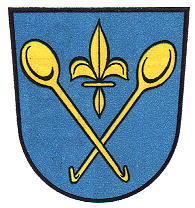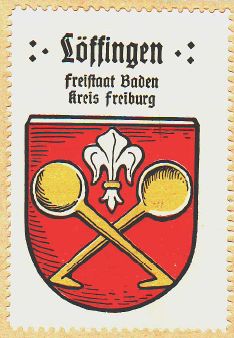Löffingen
This page is part of the German heraldry portal Deutsche Wappensammlung |
Heraldry of the World |
|
German heraldry:
|
Selected collector's items from Germany:
|
LÖFFINGEN
State : Baden-Württemberg
District (Kreis) : Breisgau-Hochschwarzwald (until 1973 Hochschwarzwald)
Additions : 1970 Seppenhofen; 1972 Göschweiler, 1974 Bachheim (1931 Neuenburg), 1975 Dittishausen, Reiselfingen, Unadingen
Official blazon
(de) In Blau zwei schräg gekreuzte goldene Kochlöffel, deren Stiele unten in auswärts weisenden Haken enden, oben zwischen den Laffen schwebend eine goldene Lilie.
Origin/meaning
The arms were granted in 1963 and confirmed in 1982. Löffingen is known as a village since 819. In 886 it became a possession of the abbey in St. Gallen. In the 13th century a new town was founded by the Counts of Fürstenberg, which in the late 13th century received city rights. The old village was incorporated into the city in the 15th century. The city was part of Fürstenberg until 1806, when it became part of Baden.
The oldest seal of the city probably dates from the end of the 13th century, but is known since 1325. It already shows a shield with two crossed spoons and a fleur-de-lis. The spoons are canting (Löffel=spoon). The origin of the fleur-de-lis is not known. There is a local story saying that the Pippin, the grandfather of Charlemagne, appointed a cook to the village in the 9th century. Thus the spoons and the fleur-de-lis of France became part of the arms.
The second seal also shows the same arms, but in the third seal, dating from the end of the 18th century, suddenly three fleur-de-lis appear (see below). The spoons are for the first time crossed. The 'new' arms were used throughout the 19th century, both in the seals and in images. The colours are known as gold and blue since the early 19th century, but later in that century the gold was sometimes replaced by silver.
| The seals of 1325, 1538 and the 18th century. |
The old composition was restored in the seals of the late 19th century, but the colours were not determined. In 1898 Hupp showed the arms on a red shield with golden spoons and a silver fleur-de-lis, see image below. He probably based his colours on the arms of Baden.
| The municipal stamp shown in 1892 |
The arms by Hupp in the Kaffee Hag albums +/- 1925 |
Contact and Support
Partners:
Your logo here ?
Contact us
© since 1995, Heraldry of the World, Ralf Hartemink 
Index of the site
Literature : Stadler, 1964-1971, 8 volumes; John, 1994;Hupp, 1920s.














